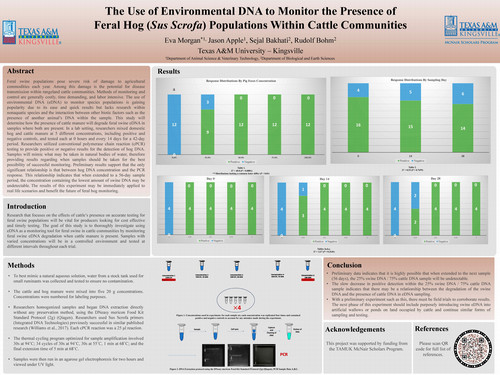Feral swine populations pose severe risk of damage to agricultural commodities each year. Among this damage is the potential for disease transmission within rangeland cattle communities. Methods of monitoring and control are generally costly, time demanding, and labor intensive. The use of environmental DNA (eDNA) to monitor species populations is gaining popularity due to its ease and quick results but lacks research within nonaquatic species and the interaction between other biotic factors such as the presence of another animal’s DNA within the sample. This study will determine how the presence of cattle manure will degrade feral swine eDNA in samples where both are present. In a lab setting, researchers mixed domestic hog and cattle manure at 5 different concentrations, including positive and negative controls, and tested each at 0 hours and every 14 days for a 42-day period. Researchers utilized conventional polymerase chain reaction (cPCR) testing to provide positive or negative results for the detection of hog DNA. Samples will mimic what may be taken in natural bodies of water, therefore providing results regarding when samples should be taken for the best possibility of successful monitoring. Preliminary results support that the only significant relationship is that between hog DNA concentration and the PCR response. This relationship indicates that when extended to a 56-day sample period, the concentration containing the lowest amount of swine DNA may be undetectable. The results of this experiment may be immediately applied to real life scenarios and benefit the future of feral hog monitoring.
Keywords: feral hog, eDNA, cattle, DNA degradation, agriculture
Faculty Mentor: Dr. Jason Apple
Department of Animal Science & Veterinary Technology


